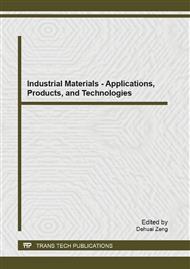[1]
S. A. Tobias, Machine Tool Vibration, Blackie and Sons Ltd, (1965).
Google Scholar
[2]
Y. Altintas, E. Budak, Analytical Prediction of Stability Lobes in Milling, Annals of the CIRP 44(1) (1995) 357-362.
DOI: 10.1016/s0007-8506(07)62342-7
Google Scholar
[3]
Y. Altintas, Analytical Prediction of Three Dimensional Chatter Stabolity in Milling, Japan Society of Mechanical Engineers International 44 (2001) 717-723.
Google Scholar
[4]
Y. Altintas, G. Stepan, D. Merdol, Z. Dombovari, Chatter Stability of Milling in Frequency and Discrete Time Domain, CIRP Journal of Manufacturing Science and Technology 1 (2008) 35-44.
DOI: 10.1016/j.cirpj.2008.06.003
Google Scholar
[5]
W. X. Tang, Q. H. Song, S. Q. Yu, S. S. Sun, B. B. Li, B. Du, X. Ai, Prediction of Chatter Stability in High-speed Finishing End Milling Considering Multi-mode Dynamics, Journal of Material Processing Technology, 209 (2009) 2585-2591.
DOI: 10.1016/j.jmatprotec.2008.06.003
Google Scholar
[6]
G. Totis, RCPM-A New Method for Robust Chatter Prediction in Milling, International Journal of Machine tools & Manufacture 49 (2009) 273-284.
DOI: 10.1016/j.ijmachtools.2008.10.008
Google Scholar
[7]
R. P. H. Faassen, N. Van de Wouw, J. A. J. Oosterling, H. Nijmaijer, Prediction of Regenerative Chatter by Modelling and Analysis of High-speed Milling, International Journal of Machine tools & Manufacture 43 (2003) 1437-1446.
DOI: 10.1016/s0890-6955(03)00171-8
Google Scholar
[8]
G. Quintana , J. Ciurana, D. Teixidor, A New Experimential Methodology for Identification of Stability Lobes Diagram in Milling Operations, International Journal of Machine tools & Manufacture 48 (2008) 1637-1645.
DOI: 10.1016/j.ijmachtools.2008.07.006
Google Scholar
[9]
J. Gradisek, M. Kalveram, T. Insperger, K. Weinert, G. Stépán, E. Govekar, I. Grabec, On Stability Prediction for Milling, International Journal of Machine tools & Manufacture 45 (2005) 769-781.
DOI: 10.1016/j.ijmachtools.2004.11.015
Google Scholar
[10]
T. Insperger, G. Stépán, P. V. Bayly, B. P. Mann, Multiple Chatter Frequencies in Milling Processes, Journal of Sound and Vibration, 262 (2003) 333-345.
DOI: 10.1016/s0022-460x(02)01131-8
Google Scholar
[11]
E. A. Butcher, H. T. Ma, E. Bueler, V. Averina, Z. Szabo, Stability of Linear Time-Periodic Delay-Fifferential Equations via Chebyshev Polynomials, International Journal for Numerical Methods in Engineering, 59 (2004) 895-922.
DOI: 10.1002/nme.894
Google Scholar
[12]
S. C. Sinha, D. H. Wu, An Efficient Computational Scheme for the Analysis of Periodic Systems, Journal of Sound and Vibration, 151 (1991) 91-117.
DOI: 10.1016/0022-460x(91)90654-3
Google Scholar
[13]
E. A. Butcher, S. C. Sinha, A Hybrid Formulation for the Analysis Time Preiodic Linear systems via Chebyshev Polynomials, Journal of Sound and Vibration 195(3) (1996) 518-527.
DOI: 10.1006/jsvi.1996.0441
Google Scholar
[14]
S. C. Sinha, E. A. Butcher, Symbolic computation of fundmental solution Matrices for Linear Time-Periodic Dynamical Systems, Journal of Sound and Vibration, 26(1) (1997) 61-8.
DOI: 10.1006/jsvi.1997.1079
Google Scholar


